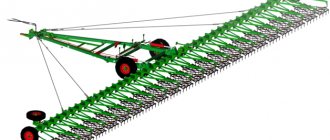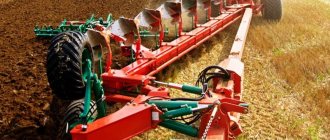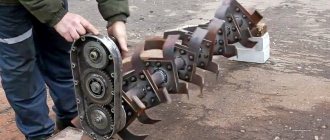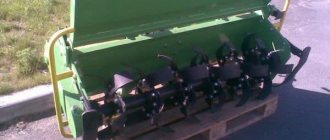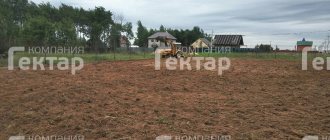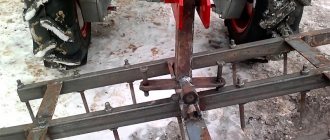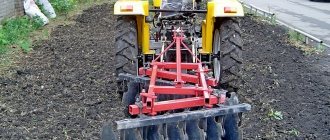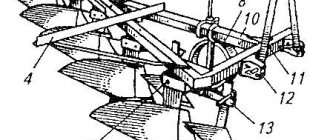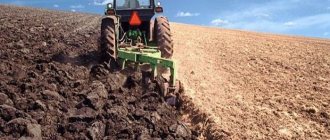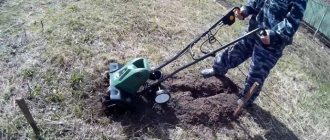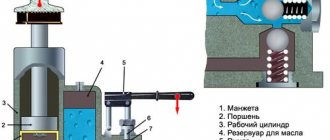The working body of tooth harrows is a tooth that works like a dihedral wedge : it splits and cuts the soil with its front edge, and further with its side edges:
- spreads
- crushes and mixes particles
- destroys large clods of soil.
The teeth are mounted on a rigid or hinged frame made up of individual links hinged to each other. Harrows and meadow harrows have an articulated frame .
Such harrows adapt well to the micro-relief of the field and ensure uniform penetration of the teeth.
By design, harrow teeth are:
- Direct
- Palmata
- Curved with a spring stand.
The teeth are classified according to their cross-sectional shape:
- with square
- round
- oval
- rectangular cross-section.
The end of a square tooth has an oblique cut. Teeth located with an oblique cut in the direction opposite to the direction of movement are deeper than those installed with an oblique cut in the direction of movement, since in the second case the vertical component of the soil reaction increases and tends to push the tooth out of the soil.
Tooth harrows are used to cultivate the soil to a depth of 3−10 cm . The diameter of the lumps after treatment is no more than 5 cm , the depth of the furrows is 3-4 cm .
winter crops are cultivated with tooth and mesh harrows : the top layer of soil is loosened and dead plants are removed. The number of damaged plants should not exceed 3% .
Meadow harrows
- combing the grass
- cut the turf
- crush and remove molehills in meadows and pastures.
Device
A tooth harrow is made up of rectangular and trough-shaped slats, at the intersection of which teeth are fixed.
The teeth on the frame are arranged so that each drives a separate groove . The distance between the furrows depends on the type of harrow and varies from 22 to 49 mm.
To prevent the harrow from becoming clogged with lumps and plant debris, adjacent teeth in the same row are secured at a distance of at least 15 cm from one another.
Square teeth have ribs in the direction of movement, oval teeth have a rounded side, rectangular teeth have a narrow or wide edge.
The depth of tillage depends on the pressure of the tooth on the soil, the length of the connecting leads, and for harrows with square teeth - and on the location of the oblique cut of the tooth in relation to the direction of movement.
A - square tooth; B - round tooth; B - tooth of oval section; G - clawed tooth; D — teeth of a mesh harrow; E—knife-shaped teeth of a meadow harrow; F - spring harrow tooth; a — BZTS-1.0; b — mesh BSO-4; c — harrow train ShB-2.5; d — needle disk of the hoe; 1 and 2 — frame strips; 3 - tooth; 4 — tow hitch; 5 — hinged beam; 6 - stand; 7 - finger; 8 and 13 - chains; 9 — bracket; 10 - traction; 11 — frame; 12 — mesh fabric; 14 — train; 15 — lever; 16 - vaga; 17 - knife; 18 - rake.
Tooth harrows are aggregated using couplings SG-21, S-18 and others with tractors of the 9−60 kN class or connected to:
- plows
- cultivators
- seeders
Each section of the harrow is equipped with a towing device in the form of hooks, to which leashes or chains are attached .
This is interesting: Skidder TDT-55 and its modifications: device, technical characteristics, photos and videos
Weight categories
Depending on the pressure on one tooth, which is determined by dividing the gravity of the link by the number of teeth, harrows are distinguished:
- heavy
- average
- lungs.
Pressure per tooth:
- heavy harrow 20−30 N
- average 10−20 N
- light 5−10 N.
1. Heavy tooth harrow BZTS-1.0 is used for:
- crushing blocks and loosening layers after plowing
- combing weeds
- processing of meadows and pastures.
2. The average tooth harrow BZSS-1.0 is intended for:
- loosening and leveling the field surface
- destroying weed seedlings
- breaking up lumps
- incorporation of fertilizers
- harrowing of seedlings of grain and industrial crops.
3. Light three-link seed harrows ZBP-0.6 and ZOR-0.7 are designed for:
- harrowing crops
- destruction of the surface crust
- placement of seeds and mineral fertilizers
- leveling the field surface before sowing.
Tooth harrow BZSS 1.0 - characteristics
Technical characteristics of tillage equipment:
- type - trailed;
- the grip has a width of 100 cm;
- maximum penetration into the soil – up to 6 cm;
- maximum processing speed – up to 12 km/h;
- productivity – 1.2 ha/h;
- pitch between teeth – 50 cm;
- pressure on the tooth – 1.2-1.5 kg;
- dimensions (L x W x H) – 1352 x 970 x 220 mm;
- weight – 35.7 kg;
- service life is approximately 8 years.
Drill for excavation work: description, types, market position.
Find out what the “Mole” ripper is here.
Read more detailed information about Honda cultivators here.
Types
1) The BSO-4 mesh harrow is intended for:
- loosening the top layer of soil and destroying weeds on crops when seedlings appear,
- for harrowing potato ridge plantings.
The harrow section is made up of a frame to which a mesh cloth is attached with chains. The BSO-4 working bodies adapt well to field unevenness. The blade links are made from round steel rods with pointed or blunt toothed ends.
Harrow sections are connected to the NUB-4.8 hitch beam with rods and chains. Chains hold the sections in the raised position. The timber is positioned so that the front and rear rows of harrow teeth are equally deep . The chains should sag , which allows the harrow sections to follow the field topography.
2) The ShB-2.5 trail harrow is used for spring harrowing in order to cover moisture and level ridges in fields plowed under plowed soil.
Two links are attached to the vaga by chains. Each link has a knife for cutting ridges, a rake for loosening the soil, and a train of steel angles connected by chains to level the soil surface.
To adjust the depth of processing, use the lever to change the angle of the knife.
3) The BP-8 mounted spring harrow is designed for combing out weeds and loosening the surface layer of soil clogged with stones. BP-8 is composed of:
- main section
- two side intermediate
- two extreme sections.
It is permissible to detach the side and outer sections and change the working width of the harrow within 8.4; 6; 3.6 and 3 m. The harrow is equipped with teeth with spring struts. The teeth are fixed on the cross bars of the frame in four rows.
To level the field surface, a leveler, rotary and spring harrows are additionally attached to the BP-8.
4) The rotary hoe is intended for spring loosening of the soil on winter crops and pre-sowing treatment in order to destroy the soil crust and weeds.
The working parts of the hoe are needle-shaped disks with concave needles with sharp ends . Several disks mounted on an axis form a battery. Adhering to the soil, the discs rotate and make 150 injections per 1 m² , destroying the soil crust.
To reduce damage to cultivated plants when processing crops, batteries are attached to the frame so that the needles are directed with the convex side in the direction of movement (the disk rotates in the direction of arrow K).
To intensively loosen the soil and destroy weeds, the batteries are rotated 180° (the disk rotates in the direction of arrow M). By changing the mass of ballast on the site, the working depth is adjusted to 9 cm.
Tags: harrow
Harrows
As noted above, harrows are used to loosen the top layer of soil, level the field surface, destroy the soil crust, crumble soil clods, destroy weeds, plant seeds and fertilizers.
Based on the design of the working parts, harrows are divided into tooth and disc .
Rice. Harrows: 1 — mounted tooth harrow of the “zigzag” type; 2 - trailed mesh; 3 — hinged spring; 4 - mounted claw; mounted with rotating knives; 6 — mounted disk (disk hoe); 7 — mounted with milling discs.
Tooth harrows
Tooth harrows are used to cultivate the soil to a depth of 3 - 10 cm. The diameter of the lumps after treatment should not be more than 5 cm, the depth of the furrows is 3 - 4 cm. In spring, winter crops are cultivated with tooth harrows and mesh harrows - the top layer of soil is loosened and dead plants are removed. The number of damaged plants should not exceed 3%. Meadow harrows are used to comb the grass, cut the turf, chop and remove molehills in meadows and pastures.
Depending on the pressure per tooth, which is determined by dividing the weight of the link by the number of teeth, harrows are distinguished between heavy, medium and light. The pressure on one tooth of a heavy harrow is 20 - 30 N (2 - 3 kg), medium 10 - 20 N (1 - 2 kg), light 5 - 10 N (0.5 - 1 kg). Heavy toothed harrows "Zigzag" are widely used on clay and loamy soils for loosening layers after plowing, destroying the soil crust, harrowing plowed land in the spring, before sowing winter and spring grains, as well as for sowing row crops, winter crops and perennial grasses. These harrows loosen the soil by 5 - 8 cm. Their teeth are fixed on the frame, have a square cross-section and are pointed at the bottom.
Medium weight harrows are used on loose and light soils. They loosen them to a depth of 4 - 6 cm.
Light harrows are capable of loosening the top layer by only 2 - 3 cm and are most used for leveling the surface and loosening the soil crust on crops.
Wire harrows are a type of toothed harrow and are designed to destroy young weeds and loosen the soil crust in grain and row crops. These harrows are classified as light harrows; their teeth loosen to a depth of 6 cm without damaging the plants. Mesh harrows are particularly flexible and loosen the soil well and evenly on all types of microrelief. When loosening soil without plants and in crops, the following mesh harrows are used: BS-2, BSN-4 and BSO-4. The most commonly used are mounted harrows consisting of six sections with 286 teeth. They harrow with these tools across the rows of plants.
Working parts of tooth harrows
The working body of tooth harrows is a tooth that works like a dihedral wedge: with its front edge it splits (cuts) the soil, and with its side edges it pushes apart, crushes and mixes its particles, destroying large clods of soil. The teeth are mounted on a rigid or hinged frame made up of individual links hinged to each other. Mesh and meadow harrows have an articulated frame. Such harrows adapt well to the micro-relief of the field and ensure uniform penetration of all teeth.
By design, the teeth are straight (see figure), clawed and curved with a spring strut. According to the cross-sectional shape, teeth with square, round, oval and rectangular cross-sections are distinguished. The end of a square tooth has an oblique cut. Teeth located with an oblique cut in the direction opposite to the direction of movement are deeper than those installed with an oblique cut in the direction of movement, since in the second case the vertical component of the soil reaction increases and tends to push the tooth out of the soil.
Rice. Tooth harrows: a - BZTS-1; b — mesh BSO-4A; c — trail harrow ShB-2.5A; d — needle disk of a hoe; d - types of teeth: I-III - square, round and oval sections, respectively; IV - clawed; V - mesh harrow; VI—knife-shaped meadow harrow; VII - spring harrow;
1, 2 — frame bar; 3 - tooth; 4 — tow hitch; 5 — hinged beam; 6 - stand; 7 - finger; 8, 13 — chains; 9 — bracket; 10 - traction; 11 - frame; 12 — mesh fabric; 14 — train; 15 — lever; 16 - vaga; 17 - knife; 18 - rake.
A tooth harrow with a classic layout is made up of rectangular (see figure) and trough-shaped bars, at the intersection of which teeth are fixed. The teeth on the frame are positioned so that each tooth has its own groove. The distance between the furrows depends on the type of harrow and varies from 22 to 49 mm. To prevent the harrow from becoming clogged with lumps and plant debris, adjacent teeth in the same row are secured at a distance of at least 15 cm from each other. Square teeth have ribs in the direction of movement, oval teeth have a rounded side, rectangular teeth have narrow or wide edges.
Tooth harrows are aggregated using couplings SG-21, S-18, etc. with tractors of class 9 - 60 kN or attached to plows, cultivators and seeders. Each section of the harrow is equipped with a towing device in the form of hooks, to which leashes or chains are attached. The depth of tillage depends on the length of the connecting leads, and for harrows with rectangular teeth - and on the location of the oblique cut of the tooth in relation to the direction of movement.
Characteristics of tooth harrows
The heavy toothed harrow BZTS-1.0 (see figure) is used for crushing blocks and loosening layers after plowing, combing out weeds, cultivating meadows and pastures.
The BZSS-1.0 medium tooth harrow is designed for loosening and leveling the field surface, destroying weed seedlings, breaking clods, applying fertilizers, harrowing seedlings of grain and industrial crops.
Lightweight three-link seed harrows ZBP-0.6 and ZOR-07 are used for harrowing crops, destroying the surface crust, planting seeds and mineral fertilizers, and leveling the field surface before sowing.
The BSO-4 mounted mesh harrow is designed for loosening the top layer of soil and destroying weeds during the period of emergence, for harrowing ridge plantings of potatoes. The harrow section is made up of a frame (see figure) to which a mesh cloth is attached with chains. Therefore, the BSO-4 working bodies (pointed teeth - the ends of hinged tooth links) adapt well to field unevenness. The links are made from round steel rods with pointed or blunt toothed ends.
Harrow sections are connected to the NUB-4.8 hitch beam with rods and chains. Chains hold the sections in the raised position. The beam must be positioned so that the front and rear rows of harrow teeth are buried equally. The chains should sag, which allows the harrow sections to follow the topography of the field.
The ShB-2.5 trail harrow is used for spring harrowing in order to cover moisture and level ridges in fields plowed under plowed soil. Two links are attached to the vaga by chains. Each link has a knife for cutting ridges, a rake for loosening the soil and a train of steel angles connected by chains to level the soil surface. To regulate the depth of processing, use the lever to change the angle of the knife. The plumbing is carried out at an angle to the pile ridges.
The articulated sectional mounted spring harrow BP-8 is designed for combing out weeds and loosening the surface layer of soil clogged with stones. BP-8 is composed of a main, two side intermediate and two outer sections. The side and outer sections can be detached and the working width of the harrow can be changed within 8.4; 6; 3.6 and 3 m. The harrow is equipped with teeth with spring struts. The teeth are fixed on the cross bars of the frame in four rows. To level the field surface, you can additionally attach a leveler, rotary and spring harrows to the BP-8.
***
Disc harrows
Disc harrows are designed for surface treatment of plowed and unplowed soils. They are good at crushing blocks and clods, loosening turf layers, and cutting turf. The working parts of these guns are batteries consisting of rotating spherical disks with a diameter of 400-500 mm. They are installed at different angles to the direction of movement of the unit. The angle formed between the plane of the disc blade and the direction of movement is called the angle of attack. Disc harrows with cut-out discs are good at loosening the soil and developing turf. These harrows, unlike disc cultivators, do not have a wheel system frame with which you can adjust the depth of soil cultivation.
Compared to tine harrows, disc harrows clog less, cut thin roots and roll over thick ones. The discs are unsuitable for working on rocky soils - their blades become chipped. According to the method of aggregation, a distinction is made between trailed and mounted disc harrows.
According to their purpose, disc harrows are divided into field, garden (light) and swamp (heavy). Light field harrows are used for processing plowed land, post-plowing loosening of turfy layers, peeling stubble, and refreshing weakly turfed meadows. Garden harrows are used to cultivate the soil to a depth of 10 cm in the rows of gardens. Heavy harrows are designed for cutting up sod layers after plowing virgin and fallow lands, disking waterlogged soils, cultivating meadows and pastures, applying fertilizers and crop residues. The depth of soil cultivation with heavy disc harrows is up to 20 cm.
Working bodies and design of disc harrows
The working body of a light disc harrow is a steel pointed spherical disc with a diameter of 450 or 510 mm. Heavy disc harrows have cut-out discs that penetrate well into the soil and intensively crush plant residues.
Several disks mounted on a square axis form a battery. The disks on the axle are placed at a certain distance from each other, and spacer bobbins are placed between them. The axle is mounted in bearings, and the battery rotates while moving. The batteries are mounted on the frame in two rows at an angle to the direction of movement. The front batteries work in a heap, the rear batteries in a heap. For better soil crumbling, the discs of the rear batteries are offset relative to the discs of the front ones.
The angle α between the plane of rotation of the disk and the line of direction of movement of the gun (angle of attack) can be changed from 0 to 21°. When processing dry and hard soils, the angle of attack is increased; when disking wet and light soils, it is reduced. As the harrow moves, the discs, engaging with the soil, rotate; the cutting edge of the disc cuts off a strip of soil and lifts it onto the inner spherical surface. Then the soil falls from a certain height and is moved to the side by a disk. As a result of moving along the disk and falling, the soil crumbles, partially turns around and mixes. As the angle of attack increases, the discs sink deeper into the soil, and its crumbling increases. The depth of cultivation is adjusted by changing the angle of attack and the pressure of the discs on the soil. The pressure is adjusted by changing the ballast mass or the compression force of the pressure springs.
Disc and rotary harrows BD, BDN, MVN
The mounted double-track disc harrow BDN-3 has four batteries with a variable number of discs. The harrow's working width is 3 or 2 m. In the first case, nine discs are installed on three batteries, and ten on the rear left one. An additional disc loosens the raw strip formed between the outermost inner discs of the front batteries. In the second case, three batteries have six disks each, and the fourth has seven. By moving the brackets along the beam and fixing them with pins, you can install a battery with disk attack angles of 12, 15, 18 and 21°. To convert the harrow to a working width of 2 m, the side bars are brought closer together, moving them along the transverse bars, and batteries with a smaller number of disks are attached.
The depth of processing is adjusted by changing the angle of attack of the disks and the mass of ballast loaded into the boxes. The BD-10 trailed disc harrow is designed for post-plow loosening of layers, pre-sowing cultivation of plowed land, peeling stubble to a depth of 10 cm, leveling the field surface on light and medium soils; it is aggregated with tractors K-700, K-700A, T-150 and T-150K. The harrow consists of four sections, a ridge cutter, caster wheels and a hydraulic system.
Batteries with ten disks with a diameter of 450 mm are attached to four side sections located symmetrically at an angle to the longitudinal ones from the harrow axis. The frames of the sections are hingedly connected to the frame; their outer ends rest on self-aligning wheels connected by a parallelogram mechanism to a hydraulic cylinder for transfer to the transport or working position. The hinged connection of the section frames ensures copying of the soil topography. Sections of working bodies can be installed with angles of attack of 12, 15, 18 and 21°.
The MVN-2.8 rotary hoe is designed for spring loosening of the soil on winter crops and pre-sowing treatment to destroy soil crust and weeds.
Three batteries are hung on the connecting beam of the hoe, hingedly connected to each other by brackets. In the transport position, the batteries are held by a rod. The working bodies of MVN-2.8 - needle disks - have concave needles with sharp ends. The diameter of the discs at the ends of the needles is 450 mm.
Each battery contains fourteen disks, loosely mounted on the axles. Adhering to the soil, the discs rotate and make 150 injections per 1 m2, completely destroying the soil crust. To reduce damage to cultivated plants when processing crops, batteries are attached so that the needles are directed with the convex side in the direction of movement. For intensive loosening of the soil and destruction of weeds, the batteries are rotated 180°. The batteries are attached to the beam so that the disks are staggered. By changing the mass of ballast on the site, the working depth is adjusted to 9 cm. The hoe's working width is 2.8 m. It is aggregated with a 9 kN class tractor.
***
Peelers
Home page
- Applicant's page
Distance education
- Group TO-81
- Group M-81
- Group TO-71
Specialties
- Veterinary
- Agricultural mechanization
- Commerce
- Vehicle maintenance and repair
Academic disciplines
- Engineering graphics
- MDK.01.01. "Car design"
- Section map
- General structure of the car
- car engine
- Car transmission
- Steering
- Brake system
- Suspension
- Wheels
- Body
- Car electrical equipment
- Basic car theory
- Basics of technical diagnostics
- Fundamentals of hydraulics and heat engineering
- Metrology and standardization
- Agreecultural machines. Agreecultural equipment
- Basics of agronomy
- Transportation of dangerous goods
- Materials Science
- Management
- Technical mechanics
- Tips for graduate student
Harrowing the soil
Harrowing is understood as soil cultivation, including technological operations of loosening, mixing and leveling the surface without turning over layers and layers of soil. It is necessary when caring for agricultural plants, to destroy the soil crust and destroy young, immature weeds.
Harrowing thins out thickened crops, embeds fertilizers, increases the aeration of the upper arable layer and retains moisture in the soil.
Depending on the cultivated crop, harrowing is carried out after sowing and seed emergence.
The best crumbling and mixing of the soil occurs when it is harrowed at a humidity of 50-70% of its full moisture capacity. When harrowing dry soils, the teeth of the implement go deep shallowly and unevenly, so the blocks are incompletely crumbled and the soil is sprayed. Too wet soil does not mix well, hardly crumbles, and an unfavorable surface microrelief is created.
When harrowing, the tractor is used less efficiently than in other types of soil cultivation; therefore, it is very important to carry it out at higher speeds with fewer harrows in the unit. The combination of harrowing with cultivation and other types of processing is considered the most optimal. This minimizes the adverse impact of heavy machinery on the soil structure. It is recommended to harrow the top layer of a plowed field at a speed of 7-8 km per hour. In the spring, when harrowing winter crops and seedlings of row crops, the tractor speed can be slightly reduced (6 km/h). When harrowing at higher speeds, the necessary loosening of the soil is achieved and labor productivity increases.
Agrotechnical requirements for harrowing
After passing the harrow, the soil should be finely lumpy, with a particle diameter of no more than 3 cm. When harrowing winter crops, row crops and perennial grasses, weeds should be completely destroyed, and no more than 3% of cultivated plants should be damaged. To avoid mistakes, subsequent strips of treated soil overlap the previous ones by 15-20 cm.
Harrowing is used as a method of caring for fallows, crops and grasslands. Harrowing can be carried out separately or simultaneously with plowing, cultivation, sowing and other techniques.
***
Functions and purpose
Harrowing is carried out to protect the plowed land from drying out the top layer and to prevent the formation of a dry soil crust that does not allow grain and industrial crops to germinate.
The tooth harrow BZSS 1.0 is intended for:
- level the field;
- loosen the top layer of soil before plowing;
- break large lumps to a size of no more than 5 cm;
- remove young immature weeds that have been pulled to the surface by the plow;
- apply fertilizers and seeds.
The implement is mounted by means of a coupling device with agricultural machinery - tractors of the 0.9-5.0 TC class, and can also be used simultaneously with other types of implements, agricultural machines (cultivators, plows, seeders) and their units.
Rotary tiller for a mini tractor: drawings and recommendations.
Information about the Salute 100 walk-behind tractor is here.
This is interesting: How to make a homemade shovel for a mini tractor?
Harrow BZSS 1.0 – price
How much does a tooth harrow BZSS 1.0 cost? The price largely depends on the manufacturer and seller, so it varies from 2450 to 3700 rubles. It is most profitable to buy agricultural implements directly from the manufacturer.
You can always find out what reviews people leave about the tooth harrow BZSS 1.0 on virtual forums or on the websites of manufacturers and sellers. It will also help to get a lot of interesting and useful information about the BZSS 1.0 tooth harrow, videos that are posted in large quantities on the Internet and are available on our website.
